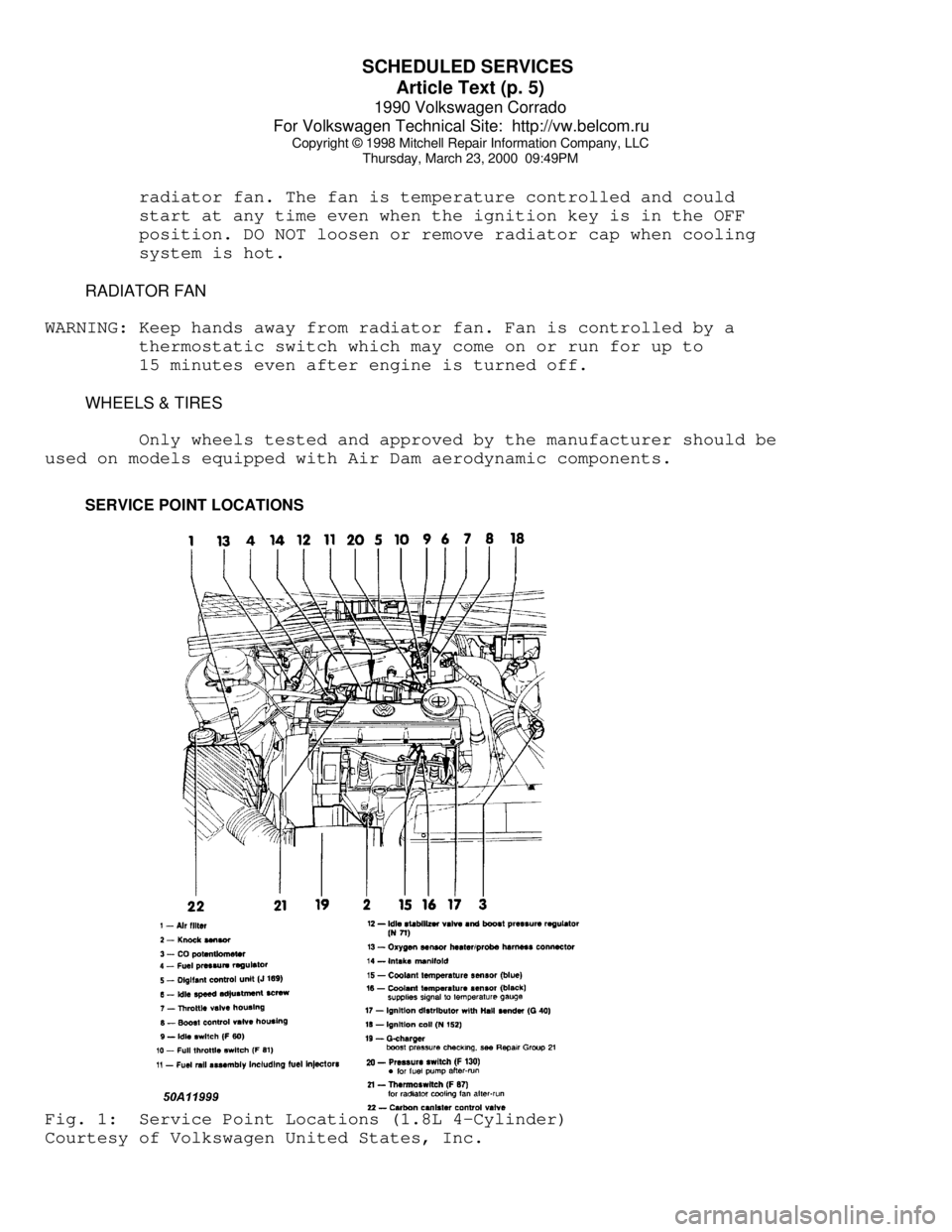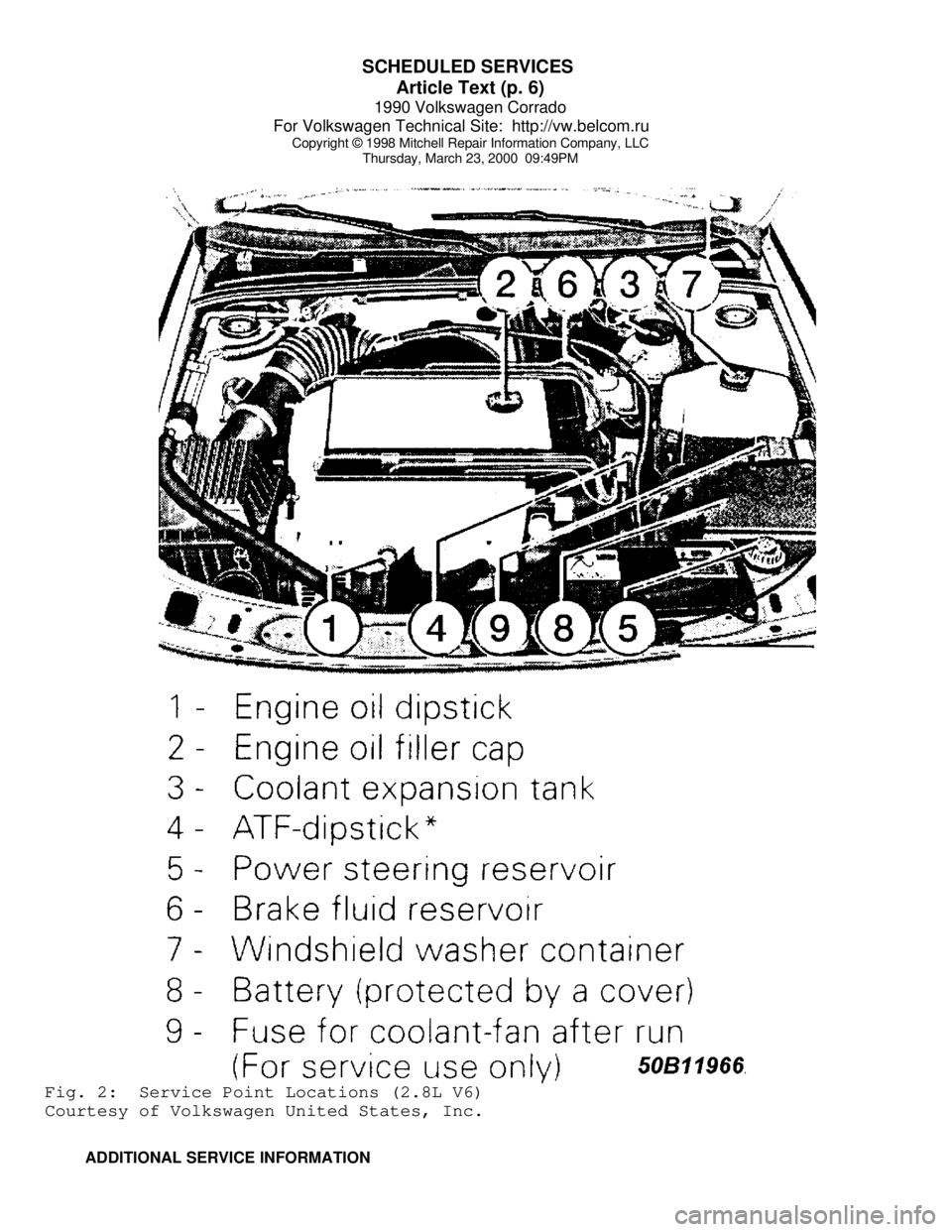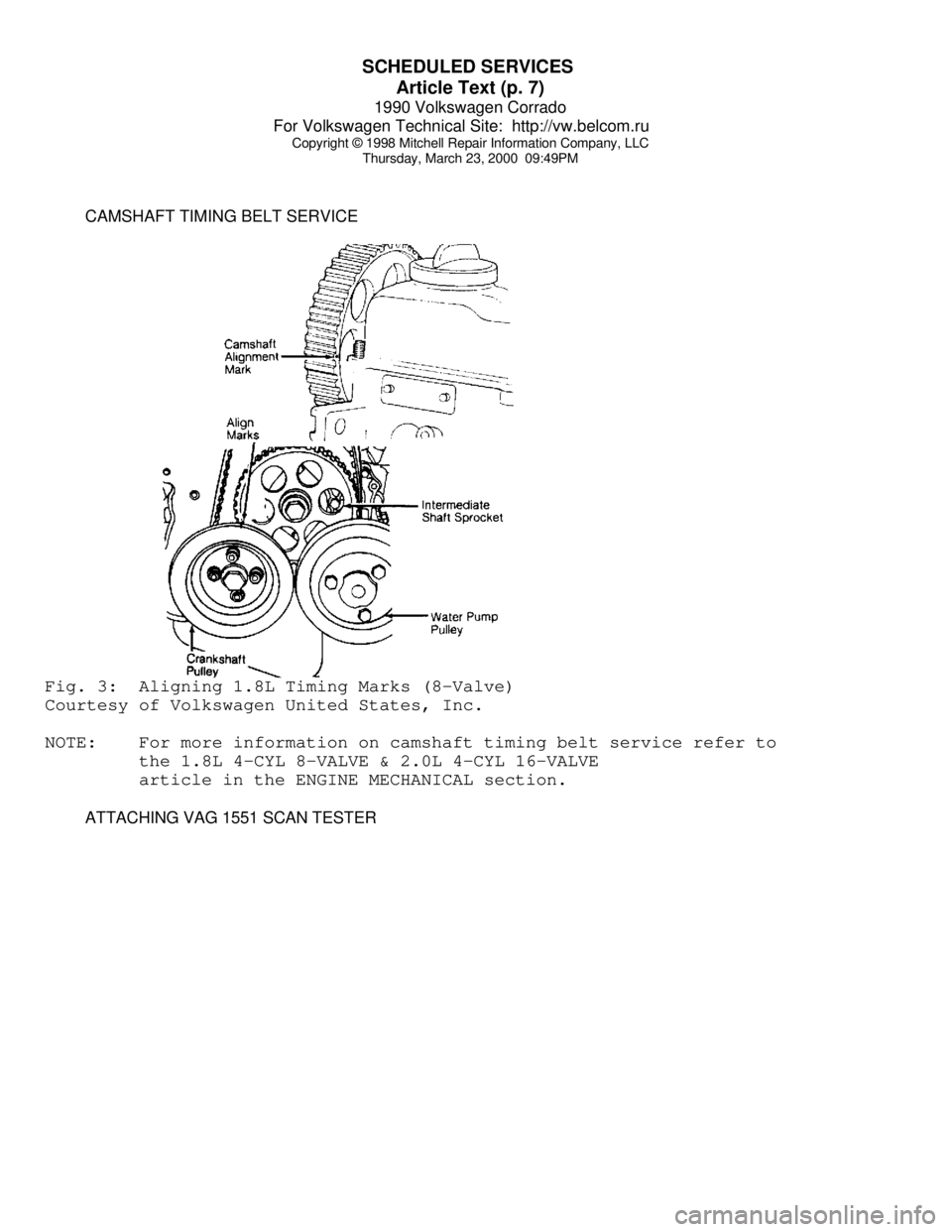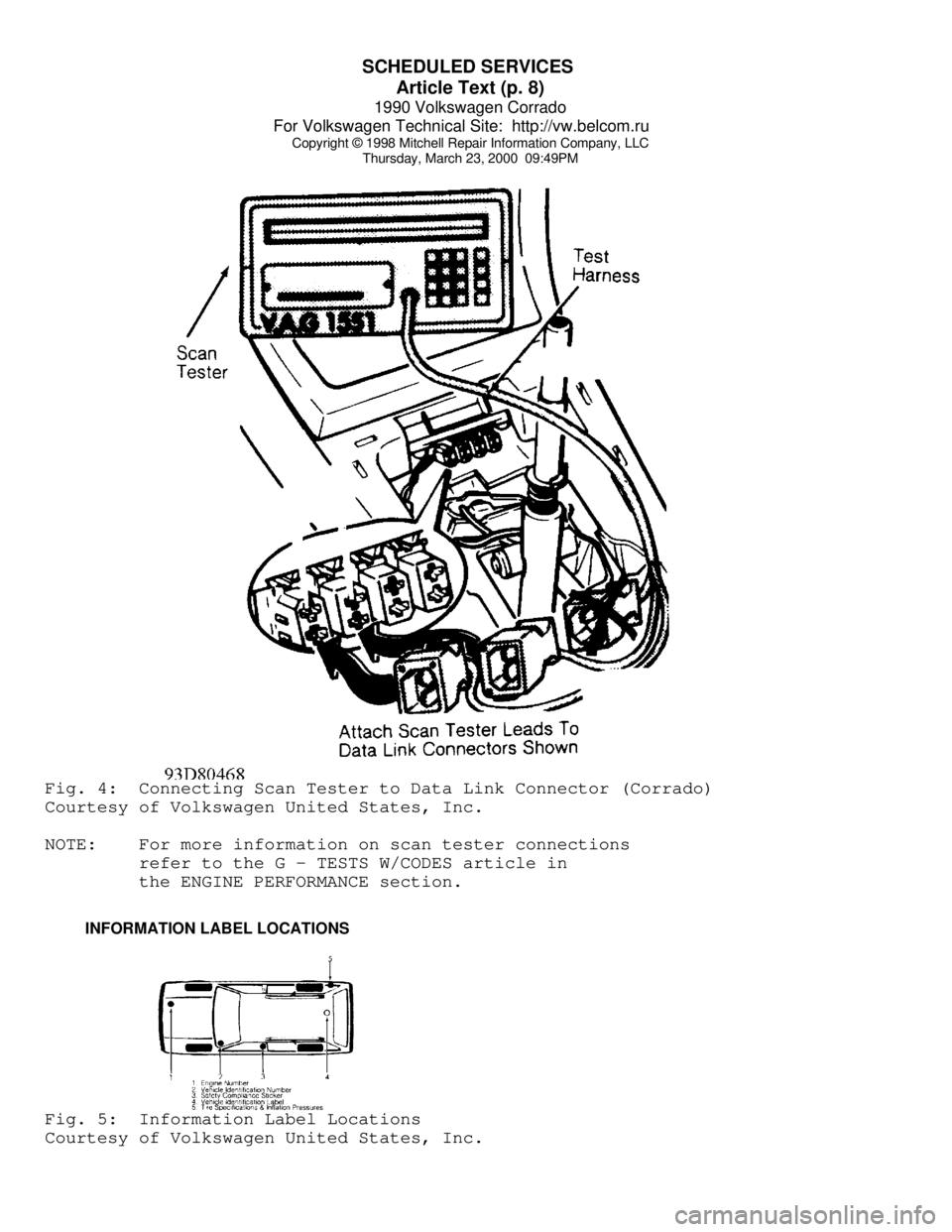1990 VOLKSWAGEN CORRADO service schedule
[x] Cancel search: service schedulePage 686 of 906

SCHEDULED SERVICES
Article Text (p. 3)
1990 Volkswagen Corrado
For Volkswagen Technical Site: http://vw.belcom.ru
Copyright © 1998 Mitchell Repair Information Company, LLC
Thursday, March 23, 2000 09:49PM
restored, driveability problems may exist on some vehicles.
These vehicles may require a relearn procedure. See COMPUTER
RELEARN PROCEDURES article in GENERAL INFORMATION section.
REPLACING BLOWN FUSES
Before replacing a blown fuse, remove ignition key, turn off
all lights and accessories to avoid damaging the electrical system. Be
sure to use fuse with the correct indicated amperage rating. The use
of an incorrect amperage rating fuse may result in a dangerous
electrical system overload.
BRAKE PAD REPLACEMENT
WARNING: Use caution when checking and/or changing brake pads, some
pads may contain asbestos which can irritate eyes and may
cause other health hazards. A water based solution should be
used to clean brake dust from wheel and brake components.
DO NOT use compressed air to blow off brake dust.
BRAKE SYSTEM
CAUTION: If brake warning light comes on while driving it indicates
a low fluid level or failure in one of the braking
circuits. If the brake pedal can be depressed further than
normal it is an indication that one of the brake circuits
is not functioning. Stop vehicle and check brake reservoir
fluid level. If level is below MIN mark, DO NOT drive
vehicle. Have it towed to a repair shop. If level is
between the MIN and MAX marks, proceed cautiously to a
repair shop.
BRAKE PAD WEAR INDICATOR
Indicator will cause a squealing or scraping noise, warning
that brake pads need replacement.
BRAKE PEDAL PRESSURE WITH ENGINE NOT RUNNING
CAUTION: Brake pedal requires extreme pressure to stop the vehicle
when the engine is not running.
CATALYTIC CONVERTER
Continued operation of vehicle with a severe malfunction
could cause converter to overheat, resulting in possible damage to
converter and vehicle.
Any modification to the exhaust system on turbo models, which
reduces exhaust backpressure, will lead to lean fuel mixtures and
excessive spark advance. This could cause serious engine damage.
COOLANT (PROPYLENE-GLYCOL FORMULATIONS)
Page 687 of 906

SCHEDULED SERVICES
Article Text (p. 4)
1990 Volkswagen Corrado
For Volkswagen Technical Site: http://vw.belcom.ru
Copyright © 1998 Mitchell Repair Information Company, LLC
Thursday, March 23, 2000 09:49PM
To avoid possible damage to vehicle use only ethylene-glycol
based coolants with a mixture ratio from 44-68% anti-freeze.
DO NOT use 100% anti-freeze as it will cause the formation
of cooling system deposits. This results in coolant
temperatures of over 300ø F (149øC) which can melt plastics.
100% anti-freeze has a freeze point of only -8
ø F (-22øC).
CAUTION: Propylene-Glycol Mixtures has a smaller temperature range
than Ethylene-Glycol. The temperature range (freeze-boil)
of a 50/50 Anti-Freeze/Water Mix is as follows:
Propylene-Glycol -26
ø F (-32øC) - 257ø F (125øC)
Ethylene-Glycol -35
ø F (-37øC) - 263ø F (128øC)
CAUTION: Propylene-Glycol/Ethylene-Glycol Mixtures can cause the
destabilization of various corrosion inhibitors. Also
Propylene-Glycol/Ethylene-Glycol has a different specific
gravity than Ethylene-Glycol coolant, which will result in
inaccurate freeze point calculations.
ELECTROSTATIC DISCHARGE SENSITIVE (ESD) PARTS
WARNING: Many solid state electrical components can be damaged by
static electricity (ESD). Some will display a warning label,
but many will not. Discharge personal static electricity by
touching a metal ground point on the vehicle prior to
servicing any ESD sensitive component.
ELECTRIC SHOCK HAZARD
WARNING: Contact with live components of ignition system while
engine is running could lead to a fatal electric shock.
ENGINE OIL
CAUTION: Never use non-detergent or straight mineral oil.
FUEL SYSTEM SERVICE
WARNING: Relieve fuel system pressure prior to servicing any fuel
system component (fuel injection models).
HALOGEN BULBS
Halogen bulbs contain pressurized gas which may explode if
overheated. DO NOT touch glass portion of bulb with bare hands. Eye
protection should be worn when handling or working around halogen
bulbs.
RADIATOR CAP
CAUTION: Always disconnect the fan motor when working near the
Page 688 of 906

SCHEDULED SERVICES
Article Text (p. 5)
1990 Volkswagen Corrado
For Volkswagen Technical Site: http://vw.belcom.ru
Copyright © 1998 Mitchell Repair Information Company, LLC
Thursday, March 23, 2000 09:49PM
radiator fan. The fan is temperature controlled and could
start at any time even when the ignition key is in the OFF
position. DO NOT loosen or remove radiator cap when cooling
system is hot.
RADIATOR FAN
WARNING: Keep hands away from radiator fan. Fan is controlled by a
thermostatic switch which may come on or run for up to
15 minutes even after engine is turned off.
WHEELS & TIRES
Only wheels tested and approved by the manufacturer should be
used on models equipped with Air Dam aerodynamic components.
SERVICE POINT LOCATIONSFig. 1: Service Point Locations (1.8L 4-Cylinder)
Courtesy of Volkswagen United States, Inc.
Page 689 of 906

SCHEDULED SERVICES
Article Text (p. 6)
1990 Volkswagen Corrado
For Volkswagen Technical Site: http://vw.belcom.ru
Copyright © 1998 Mitchell Repair Information Company, LLC
Thursday, March 23, 2000 09:49PMFig. 2: Service Point Locations (2.8L V6)
Courtesy of Volkswagen United States, Inc.
ADDITIONAL SERVICE INFORMATION
Page 690 of 906

SCHEDULED SERVICES
Article Text (p. 7)
1990 Volkswagen Corrado
For Volkswagen Technical Site: http://vw.belcom.ru
Copyright © 1998 Mitchell Repair Information Company, LLC
Thursday, March 23, 2000 09:49PM
CAMSHAFT TIMING BELT SERVICEFig. 3: Aligning 1.8L Timing Marks (8-Valve)
Courtesy of Volkswagen United States, Inc.
NOTE: For more information on camshaft timing belt service refer to
the 1.8L 4-CYL 8-VALVE & 2.0L 4-CYL 16-VALVE
article in the ENGINE MECHANICAL section.
ATTACHING VAG 1551 SCAN TESTER
Page 691 of 906

SCHEDULED SERVICES
Article Text (p. 8)
1990 Volkswagen Corrado
For Volkswagen Technical Site: http://vw.belcom.ru
Copyright © 1998 Mitchell Repair Information Company, LLC
Thursday, March 23, 2000 09:49PMFig. 4: Connecting Scan Tester to Data Link Connector (Corrado)
Courtesy of Volkswagen United States, Inc.
NOTE: For more information on scan tester connections
refer to the G - TESTS W/CODES article in
the ENGINE PERFORMANCE section.
INFORMATION LABEL LOCATIONSFig. 5: Information Label Locations
Courtesy of Volkswagen United States, Inc.
Page 692 of 906

SCHEDULED SERVICES
Article Text (p. 9)
1990 Volkswagen Corrado
For Volkswagen Technical Site: http://vw.belcom.ru
Copyright © 1998 Mitchell Repair Information Company, LLC
Thursday, March 23, 2000 09:49PM
CAMSHAFT TIMING BELT REPLACEMENT INFORMATION
CAUTION: Failure to replace a faulty camshaft timing belt may result
in serious engine damage.
The condition of camshaft drive belts should always be
checked on vehicles which have more than 50,000 miles. Although some
manufacturers do not recommend belt replacement at a specified
mileage, others require it at 60,000-100,000 miles. A camshaft drive
belt failure may cause extensive damage to internal engine components
on most engines, although some designs do not allow piston-to-valve
contact. These designs are often called "Free Wheeling".
Many manufacturers changed their maintenance and warranty
schedules in the mid-1980's to reflect timing belt inspection and/or
replacement at 50,000-60,000 miles. Most service interval schedules in
this manual reflect these changes.
Belts or components should be inspected and replaced if any
of the following conditions exist:
* Cracks Or Tears In Belt Surface
* Missing, Damaged, Cracked Or Rounded Teeth
* Oil Contamination
* Damaged Or Faulty Tensioners
* Incorrect Tension Adjustment
Inspect camshaft timing belt condition every 20,000 miles.
Replace belt as necessary.
SEVERE & NORMAL SERVICE DEFINITIONS
NOTE: Use the Severe Service schedule if the vehicle to be serviced
is operated under ANY (one or more) of these conditions:
Service is recommended at mileage intervals based on vehicle
operation. Service schedules are based on the following primary
operating conditions:
Normal Service
* Driven More Than 10 Miles Daily
* No Operating Conditions From Severe Service Schedule
Severe Service (Unique Driving Conditions)
* Short Trips In Freezing Temperatures
* Towing Or Heavily Loaded
* Severe Dust Conditions
* Hot Weather, Stop-And-Go Driving
* Extensive Idling
SEVERE SERVICE REQUIREMENTS (PERFORM W/SERVICE SCHEDULES)
Page 693 of 906

SCHEDULED SERVICES
Article Text (p. 10)
1990 Volkswagen Corrado
For Volkswagen Technical Site: http://vw.belcom.ru
Copyright © 1998 Mitchell Repair Information Company, LLC
Thursday, March 23, 2000 09:49PM
NOTE: The following services are to be performed on vehicles
subjected to severe service. See SEVERE & NORMAL SERVICE
DEFINITIONS. This service is to be performed in addition
to the normal services listed in the NORMAL MAINTENANCE
SERVICE SCHEDULES.
SEVERE SERVICE CONDITIONS/ACTIONS TABLEÚÄÄÄÄÄÄÄÄÄÄÄÄÄÄÄÄÄÄÂÄÄÄÄÄÄÄÄÄÂÄÄÄÄÄÄÄÄÄÄÄÄÄÂÄÄÄÄÄÄÄÄÄÄÄÄÄÄÄÄÄÄÄÄÄÄÄÄÄ¿
³ Condition
³ Action ³ Item ³ Perform Every (1) ³
ÃÄÄÄÄÄÄÄÄÄÄÄÄÄÄÄÄÄÄÅÄÄÄÄÄÄÄÄÄÅÄÄÄÄÄÄÄÄÄÄÄÄÄÅÄÄÄÄÄÄÄÄÄÄÄÄÄÄÄÄÄÄÄÄÄÄÄÄÄ´
³ Short Trips In
³ Replace ³Engine Oil & ³ 3,750 Miles or 3 Months ³
³ Freezing
³ ³ Filter ³ ³
³ Temperatures
ÃÄÄÄÄÄÄÄÄÄÅÄÄÄÄÄÄÄÄÄÄÄÄÄÅÄÄÄÄÄÄÄÄÄÄÄÄÄÄÄÄÄÄÄÄÄÄÄÄÄ´
³
³ Replace ³ A/T Fluid ³ 30,000 Miles ³
³
ÃÄÄÄÄÄÄÄÄÄÅÄÄÄÄÄÄÄÄÄÄÄÄÄÅÄÄÄÄÄÄÄÄÄÄÄÄÄÄÄÄÄÄÄÄÄÄÄÄÄ´
³
³ Service ³ A/T: Clean ³ 30,000 Miles ³
³
³ ³ Pan & ³ ³
³
³ ³ Strainer ³ ³
ÃÄÄÄÄÄÄÄÄÄÄÄÄÄÄÄÄÄÄÅÄÄÄÄÄÄÄÄÄÅÄÄÄÄÄÄÄÄÄÄÄÄÄÅÄÄÄÄÄÄÄÄÄÄÄÄÄÄÄÄÄÄÄÄÄÄÄÄÄ´
³Towing Or Heavily
³ Replace ³Engine Oil & ³ 3,750 Miles or 3 Months ³
³ Loaded
³ ³ Filter ³ ³
³
ÃÄÄÄÄÄÄÄÄÄÅÄÄÄÄÄÄÄÄÄÄÄÄÄÅÄÄÄÄÄÄÄÄÄÄÄÄÄÄÄÄÄÄÄÄÄÄÄÄÄ´
³
³ Replace ³ A/T Fluid ³ 30,000 Miles ³
³
ÃÄÄÄÄÄÄÄÄÄÅÄÄÄÄÄÄÄÄÄÄÄÄÄÅÄÄÄÄÄÄÄÄÄÄÄÄÄÄÄÄÄÄÄÄÄÄÄÄÄ´
³
³ Service ³ A/T: Clean ³ 30,000 Miles ³
³
³ ³ Pan & ³ ³
³
³ ³ Strainer ³ ³
ÃÄÄÄÄÄÄÄÄÄÄÄÄÄÄÄÄÄÄÅÄÄÄÄÄÄÄÄÄÅÄÄÄÄÄÄÄÄÄÄÄÄÄÅÄÄÄÄÄÄÄÄÄÄÄÄÄÄÄÄÄÄÄÄÄÄÄÄÄ´
³ Severe Dust
³ Replace ³Engine Oil & ³ 3,750 Miles or 3 Months ³
³ Conditions
³ ³ Filter ³ ³
³
ÃÄÄÄÄÄÄÄÄÄÅÄÄÄÄÄÄÄÄÄÄÄÄÄÅÄÄÄÄÄÄÄÄÄÄÄÄÄÄÄÄÄÄÄÄÄÄÄÄÄ´
³
³ Replace ³ A/T Fluid ³ 30,000 Miles ³
³
ÃÄÄÄÄÄÄÄÄÄÅÄÄÄÄÄÄÄÄÄÄÄÄÄÅÄÄÄÄÄÄÄÄÄÄÄÄÄÄÄÄÄÄÄÄÄÄÄÄÄ´
³
³ Service ³ A/T: Clean ³ 30,000 Miles ³
³
³ ³ Pan & ³ ³
³
³ ³ Strainer ³ ³
ÃÄÄÄÄÄÄÄÄÄÄÄÄÄÄÄÄÄÄÅÄÄÄÄÄÄÄÄÄÅÄÄÄÄÄÄÄÄÄÄÄÄÄÅÄÄÄÄÄÄÄÄÄÄÄÄÄÄÄÄÄÄÄÄÄÄÄÄÄ´
³ Hot Weather,
³ Replace ³Engine Oil & ³ 3,750 Miles or 3 Months ³
³ Stop-And-Go
³ ³ Filter ³ ³
³ Driving
ÃÄÄÄÄÄÄÄÄÄÅÄÄÄÄÄÄÄÄÄÄÄÄÄÅÄÄÄÄÄÄÄÄÄÄÄÄÄÄÄÄÄÄÄÄÄÄÄÄÄ´
³
³ Replace ³ A/T Fluid ³ 30,000 Miles ³
³
ÃÄÄÄÄÄÄÄÄÄÅÄÄÄÄÄÄÄÄÄÄÄÄÄÅÄÄÄÄÄÄÄÄÄÄÄÄÄÄÄÄÄÄÄÄÄÄÄÄÄ´
³
³ Service ³ A/T: Clean ³ 30,000 Miles ³
³
³ ³ Pan & ³ ³
³
³ ³ Strainer ³ ³
ÃÄÄÄÄÄÄÄÄÄÄÄÄÄÄÄÄÄÄÅÄÄÄÄÄÄÄÄÄÅÄÄÄÄÄÄÄÄÄÄÄÄÄÅÄÄÄÄÄÄÄÄÄÄÄÄÄÄÄÄÄÄÄÄÄÄÄÄÄ´
³ Extensive Idling
³ Replace ³Engine Oil & ³ 3,750 Miles or 3 Months ³
³
³ ³ Filter ³ ³
³
ÃÄÄÄÄÄÄÄÄÄÅÄÄÄÄÄÄÄÄÄÄÄÄÄÅÄÄÄÄÄÄÄÄÄÄÄÄÄÄÄÄÄÄÄÄÄÄÄÄÄ´
³
³ Replace ³ A/T Fluid ³ 30,000 Miles ³
³
ÃÄÄÄÄÄÄÄÄÄÅÄÄÄÄÄÄÄÄÄÄÄÄÄÅÄÄÄÄÄÄÄÄÄÄÄÄÄÄÄÄÄÄÄÄÄÄÄÄÄ´